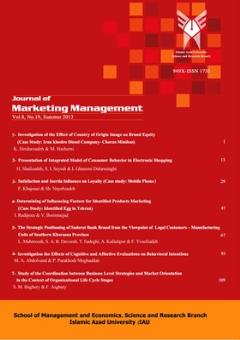-
-
List of Articles
-
Open Access Article
1 - The effect of cultural identification, attractiveness, trustworthiness, and fulfillment of online shopping websites on the repeat purchase intention and the effective relationship of product and service attractiveness
Morteza Baghaei Shahrivar kambiz heidarzadeh mohamadali abdolvand -
Open Access Article
2 - Identifying the in-store non-verbal cues affecting the buying behavior of customers in the home appliance industry
Maryam Jaberi Karim Hamdi Farhad Hosseinzadeh lotfi -
Open Access Article
3 - Designing and explaining the model of consumer personality traits based on the impulse buying approach in international market with a mixed method
Rahele Ansari Seyyed Hassan Hatami-nasab Shahnaz Nayebzadeh -
Open Access Article
4 - Applying a qualitative meta-composite approach in order to provide a brand repositioning model for companies active in the electricity industry
babak roozbahani S. Sarmad Saeidi behrooz ghasemi -
Open Access Article
5 - Designing a nation branding model in the field of industrial products and services export
Alireza Zamani Kambiz Jalali Farahani Mahmoud Samiei Nasr Nasrin Akhondi -
Open Access Article
6 - Presenting an integrated model of online repurchase intention in chain stores using the multi-ground theory method
mehdi berah moghadam Hossein Hakimpour Mehdi Mahmoodzadeh Mohammad Mohammadi -
Open Access Article
7 - Presenting a Quantitative Model of the Use of Social Media Influencers in the Behavior of Luxury Cosmetics Industry Consumers
Seyed Aref Asgharzadeh Shiadeh mehd Rouholamini Shiba Masoumi Azadeh Kiapour -
Open Access Article
8 - Prairie a limited effect, as a craving for a decadence, with a crop of passion, with a brand, with a mianji inscription, a realization of a luxe bodn calla
amir hooshang nazarpouri Mojtaba Hasanvand Nasrin Hasanvand Razie Jazaire -
Open Access Article
9 - Designing a competitive advantage model with an emphasis on brand identity based on foundational data theory in the apparel industry
Iman Akhbarati Fariz Taherikia Seyed mehdi jalali -
Open Access Article
10 - interactive marketing model based on the national system of innovation in industrial tools
Ali Hajiaghabozorgi Mahmoud Ahmadi sharif Peyman Ghafari Ashtiani
-
The rights to this website are owned by the Raimag Press Management System.
Copyright © 2021-2025







